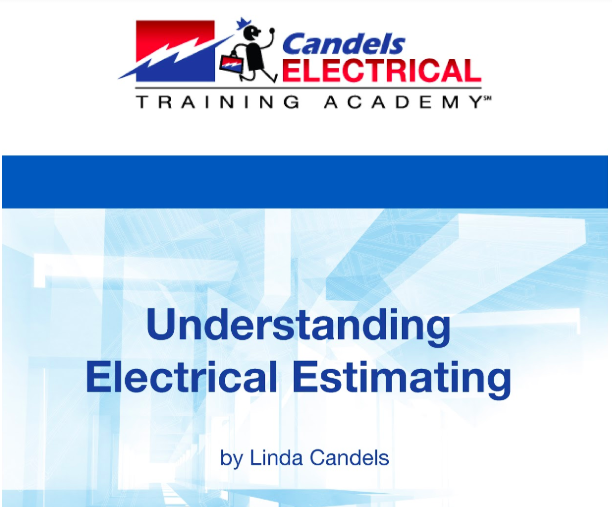With four successful electrical estimating training sessions under their belts, Linda and Marc Candels are ready to kick off 2019 with their fifth Electrical Estimating Training and Apprenticeship which starts on January 29.
The Candels Electrical Training Academy teaches the art and science of electrical estimating. The four-month session covers a wide range of topics as it dives into great detail about electrical estimating. The Candels team builds the foundation to each student’s estimating experience by thoroughly reviewing estimating theory. The estimator’s role, building construction types, labor units, material pricing, specification review, and drawing review are discussed in detail. All training is then be put into practice via student projects that will be completed during the semester. There is no other program around of its kind! In four months, each student should be able to function as a junior level estimator.
Vice President and co-owner Linda Candels says it’s fairly simple to get started in this field. With a background in marketing analysis and management, she applied her expertise of seeking similarities and differences to her new field: Electrical Estimating. Without any specific background in electrical estimating, Linda said, “All you need is aptitude and attitude. If students are engaged and participate in class, they can succeed.”
Linda’s 15-year electrical estimating career alongside her husband, co-owner and President Marc Candels speaks for itself. Linda and Marc take the business of estimating to heart – they’ve been in business for almost as long as they’ve been married. How many spouses can live and work together for more than a decade? They truly care about the industry and want the industry to move forward in a positive direction—and their Estimating Academy demonstrates this in spades.
The Candels estimating team welcomes all levels of estimators. “Company owners also participate. They know the business but realize they need that formal detailed training in estimating,” Linda said.
About the Classes
Classes are held online twice a week via live webinar. Instructors are available to answer questions during the webinar, plus the webinars are recorded for reference at any point in time.
Samantha Kosteck Nagy, a project manager and estimator with Hy-Power Electric Co., was thoroughly satisfied with the course. “For the amount of time this course lasted, it was perfect for me – not rushed. They provided a syllabus that we followed throughout the course, too. This helped keep all of us on track.” And in a somewhat male-dominated field, it’s refreshing to see more women make electrical estimating their career.
Additionally, the Candels team conducts unlimited one-on-one training outside of regular class hours. This is a major advantage to taking this specific training with the Candels.
Samantha took advantage of that. “One-on-one training with Linda was KEY. This was my favorite part of the course by far, and also for me, the most informative…this was so incredibly helpful.”
Butch Naumann agrees. Butch has been an estimator for 14 years and felt he was missing something. He utilized the one-on-one sessions several times. “Linda and Marc are phenomenal. Marc helped me with ConEst and PlanSwift and took the time to help me with other projects.” Butch is owner and employer of five at BN Electric & Communications in Pittsburgh, PA.
Linda and Marc Candels are highly invested in not only the industry but leading their students to a path of success. “We want to elevate the industry because people are bidding jobs below cost.” The Candels want to teach electrical estimators that when they see a low bid, they need to look at the true cost of a project.
Linda adds, “Consider the quality of work you’ll be getting, the experience, when you should walk away – no one ever tells them that stuff. We want to elevate the industry so projects are priced appropriately and estimators do not fall prey to low bids.”
Why Should I Take this Course?
Linda and Marc hold the unwavering belief: “Solid theory combined with practice. The more you learn, the more value you have to employers and yourself. It’s a relatively small investment for potential lifelong earning capacity.”
And Butch couldn’t agree more.
“Linda and Marc make it very easy and fun. Not only did I have them to go to, but I also had the classes to go back to [online]. Before I took the classes, I wasn’t bidding the type of bidding we’re doing now. The classes saved me so much time. It’s worth every dime. The software programs cut my estimating time and I’m able to bid more work more frequently. We have doubled the work we’ve bid and double our revenue.” Butch now plans to expand his business.
Samantha says, “We were able to contact Marc and Linda at any time to either help us prepare our bids, answer questions, or go over our bids. They were extremely flexible, accommodating and responsive. This course has provided me with more knowledge and tools to use. I am definitely in a better position after taking the course than I was prior to taking the course. I feel more confident and secure in my estimating capabilities…I accomplish more work in less time.”
Job Prospects
Employers look at real-world experience. Depending upon where you live, with the right training, electrical estimators can earn upwards of $250,000/year without an official college degree.
The right training and real-world experience will guide you to a path of success. And this is exactly what the Candels team provides.
Samantha sums it up well. “I would highly recommend this course. I have been in this industry for a long time and I have not come across a more extensive or thorough course.”
Want more details? See below and don’t miss out on this unique and fun opportunity.









 A new electrical estimating book hits the press! Candels Estimating introduces its first e-book:
A new electrical estimating book hits the press! Candels Estimating introduces its first e-book: 
